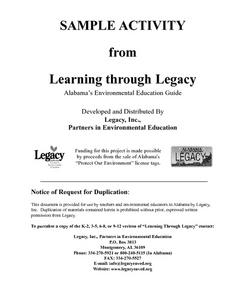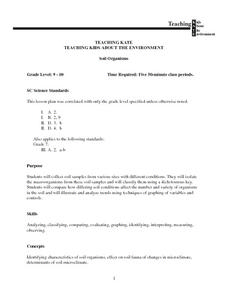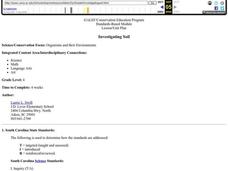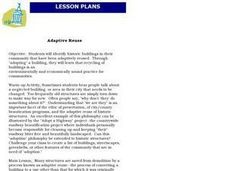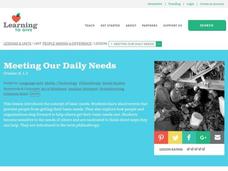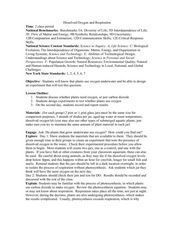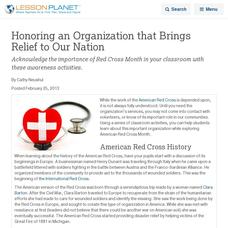Curated OER
Junk Mail Airmail
Third graders explore how to make a contribution to end the junk mail problem. In this junk mail lesson students collect junk mail, identify the resources used and construct junk mail airplanes.
Curated OER
Animal Tracks
Sixth graders practice using logic and scientific proof while examining animal tracks. In this scientific method lesson, 6th graders identify different animals and the type of tracks they leave behind by observing photographs. Students...
Curated OER
The Tree of Life
Students discover the amount of diversity that exists in a local area using simple techniques that make observing biodiversity easy and enjoyable. They select a tree to study, collect vials of specimens, then identify the arthropod.
Curated OER
How Germs Spread
Learners conduct a test to help them visualize the spread of
germs. They identify that a pandemic is an epidemic (an outbreak of an infectious disease) that spreads across a large region or even worldwide. Finally, students state...
Curated OER
Maintaining the Natural Balance
For this pollution worksheet, students will identify the sources of air, water, and land pollution. Then the students will list some of the problems caused by these types of pollutions in 3 short answer questions.
Curated OER
Watchable Wildlife Checklist
In this wildlife worksheet, students will read over a list of 28 native animal species, their needs, and interesting characteristics. This list can be used as a checklist when out on a hike or in the school yard to identify common wildlife.
Curated OER
People making a difference
Pupils identify resources that all humans need and compare needs and wants. In this needs and wants lesson plan, students discuss with their teacher situations in which people need or want items and how some people don't have the...
Curated OER
Pet Overpopulation
Young scholars examine pet overpopulation. In this animal welfare lesson, students discuss the causes and effects of pet overpopulation. Young scholars color in an animal page and identify the responsibilities of owning a pet.
Curated OER
The Beach
In this natural environment worksheet, students cut out ways litter affects the beach environment. Students draw pictures in the boxes to match. Students then draw their favorite beach activity and list the things they can do at the beach.
Curated OER
All I Want for Christmas is a Nice, Clean Earth
Young scholars observe properties of items, determine time it takes for organic/inorganic items to decompose, identify differences/similarities between decomposition, identify practical uses in litter/garbage control, & establish...
Curated OER
Posters and People
Young scholars create and design posters reflecting the types of litter harmful to aquatic wildlife. They explain the dangers of fishing line to aquatic wildlife, plastic bags to dolphins, and fish nets to fish. They design a poster to...
Curated OER
Trash Count
Students identify pollution around their local community. They discuss the sources of polution and categorize objects based on their properties. They discover ways to make changes to the environment and how to inform the public.
Curated OER
Soil Organisms
Young scholars work together to collect soil samples from different locations. In the samples, they identify the macroorganisms and classify them. They identify the conditions that affect how macroorganisms grow. They also analyze and...
Curated OER
Investigating Soil
Fourth graders swap local soil samples with another school and examine the differences. They research soil properties, identify organisms that live in soil, create and maintain a biome of soil decomposition and design a poster to present...
Curated OER
Adaptive Reuse
Students identify historic buildings in their community that have been adaptively reused. Through "adopting" a building, they will study how recycling of buildings is an environmentally and economically sound practice for communities.
Curated OER
People Making a Difference
Students research the idea of basic needs, study philanthropists in their community, and think about ways to help others receive basic needs. In this needs and philanthropy lesson, students brainstorm about basic needs. Students use...
Curated OER
Earth Day
In this crossword puzzle worksheet, students identify the words that relate to Earth Day by reading the 14 clues. Students complete the crossword puzzle with the clues.
Curated OER
School Forest Lesson- Looking at Literature
Students compare what they learned though literature to the school forest. In this environment lesson, students visit the forest surrounding their school to listen to literature and identify objects in nature. Students create a display...
Curated OER
Tropical Rainforests
Students create their own rainforest environment. This tropical rainforest lesson, introduces where rainforests are located, their real world connections, and their structural make up. It includes further resources online.
Curated OER
Metaphors Are Like Similes...Right?
Build the basis for critical thinking by increasing mastery of metaphors, similes, and analogies. Clear up the confusion that often marks lessons on figurative langauge. A very insightful article, full of great links.
Curated OER
Dissolved Oxygen and Respiration
Students are presented with the question, "Do plants that grow underwater use oxygen?" They create an experiment to test the presence of dissolved oxygen in the water using provided materials. Student experiments include a control jar as...
Curated OER
Change Since 1609
Students recognize how the climate of the Hudson Valley has changed since the last glaciation. They explain these changes using a reconstruction of the land use changes in the Hudson Valley composed of confetti, Ziploc bags and other...
Curated OER
Paleoclimate of the Hudson Valley
Students recognize how the climate of the Hudson Valley has changed since the last glaciation and be able to explain these changes. They reconstruct the paleoclimate of the Hudson Valley.
Curated OER
Honoring an Organization that Brings Relief to Our Nation
Acknowledge the importance of Red Cross Month in your classroom with these awareness activities.












